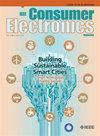一种3kbit低成本、低功耗EEPROM集成到RFID标签集成电路中,可用于生物消费电子产品
IF 10.9
2区 计算机科学
Q1 ENGINEERING, ELECTRICAL & ELECTRONIC
引用次数: 0
摘要
RFID作为生物信号采集和数据存储之间的桥梁,在植入式医疗传感器和可穿戴医疗设备等集成生物消费电子产品中具有巨大的应用潜力。EEPROM作为一种重要的生物特征信息存储工具,在相关领域的研究中一直被忽视。本文采用中芯国际0.13 μ m EEPROM 2P6M CMOS工艺开发了一种可用于无源RFID标签ic的3kbits EEPROM,芯片面积为338.28~ 310.78~ 3mu $ m,读写操作的平均功耗分别为560 nA和31 μ $ a,比目前的先进文献低62%和6.5%。本文提出了一种新颖的读取电路,该电路仅使用一个简单的逆变器读取数据,与传统的使用运算放大器的读出方法相比,大大节省了功耗和面积。此外,本文提出了一种功率优化的电荷泵,当电压上升到高压时,开关低频时钟产生的分频器,以降低功耗。为了实现低成本优势,本文采用MIM (shd)层和M4层分离的方法将器件置于MIM电容器下。因此,从商业角度来看,它更适合生物消费电子产品。本文章由计算机程序翻译,如有差异,请以英文原文为准。
A 3 Kbits of Low-Cost, Low-Power EEPROM Integrated Into RFID Tag Integrated Circuits Available for Bio-Consumer Electronics
RFID has great potential for applications in integrated bio-consumer electronics such as implantable medical sensors and wearable medical devices as a bridge between bio-signal acquisition and data storage. EEPROM, an important tool for storing biometric information, has been neglected in research in related fields. This paper presents a 3 Kbits EEPROM that could be utilized for passive RFID tag ICs, developed in SMIC $0.13\mu $ m EEPROM 2P6M CMOS process, boasting a chip area of $338.28~\mu $ m ${\times } 310.78~\mu $ m. The average power consumption for read and write operations was 560 nA and $31~\mu $ A respectively, which is 62% and 6.5% lower than the current state-of-the-art literature. This paper proposes a novel reading circuit that reads data using only one simple inverter, greatly saving power consumption and area compared with the traditional readout method using operational amplifiers. Furthermore, this paper proposes a power-optimized charge pump that switches the frequency divider generated by the low-frequency clock when the voltage rises to a high voltage to reduce power consumption. To fulfill the low-cost advantage, this paper places the device under the MIM capacitor using the MIM (shd) and M4 layers to separate. Thus, it is more suitable for bio-consumer electronics from a commercial perspective.
求助全文
通过发布文献求助,成功后即可免费获取论文全文。
去求助
来源期刊
CiteScore
7.70
自引率
9.30%
发文量
59
审稿时长
3.3 months
期刊介绍:
The main focus for the IEEE Transactions on Consumer Electronics is the engineering and research aspects of the theory, design, construction, manufacture or end use of mass market electronics, systems, software and services for consumers.

 求助内容:
求助内容: 应助结果提醒方式:
应助结果提醒方式:


